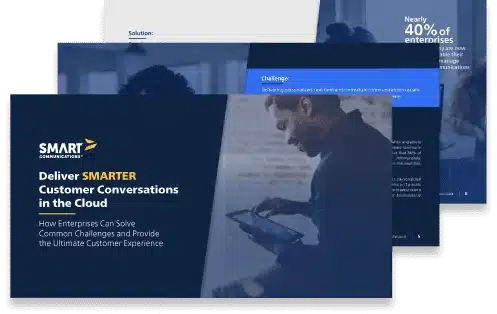5 Key Trends Impacting the Insurance Industry
The insurance industry has been under pressure to innovate for quite some time. However, the implications of the global pandemic have only accelerated the need to be more agile and responsive to customer demands. And as we enter a post-pandemic world, insurers are continuing to pivot to new ways of working and engaging with customers.
As a result, carriers are increasingly investing in digital transformation initiatives to meet the needs of both employees and their end customers. In this post, we dive into how the ongoing impact of the pandemic, changing customer expectations, and digital transformation will continue to impact the insurance industry, plus strategies for success in the months and years ahead. Read on to learn more about key insurance industry trends customers expect from their insurance carrier.
- Work from Home (WFH) impacts employees and policies
Over the past 12+ months, massive shifts in where people work have forced insurers to figure out how to make their own workforce productive while simultaneously maintaining a positive customer experience. While digital solutions enabled the shift to WFH, they also exposed inefficiencies in existing processes.
According to Tom King, Director of Insurance at Salesforce, “In the insurance industry…there are a tremendous amount of manual processes and workarounds. Employees want to do the right thing and as a result, have been able to get work done despite cumbersome systems. The pandemic has forced business leaders to look in the mirror and address these issues once and for all.”
Business leaders must ensure they make the remote work experience as seamless and efficient as possible, and employees must be able to collaborate across systems and teams while ensuring security and compliance standards. This means continuing to implement processes that allow employees to be successful from home and investing in the necessary technology to support a digital-first approach.
- Rising customer expectations highlight digital deficiencies
Anything consumers want is now only a few taps or clicks away. With COVID-19 forcing many to rely solely on digital means to meet even their most basic needs, the world has seen a seismic shift. Now customers have heightened expectations for anything and everything to be digital, including insurance.
This puts digitally deficient insurers in a bind, as customers increasingly expect everything to be easy and transparent. Today, when customers purchase new policies or make claims, they expect clear communications at every stage of the journey, including self-service tools they can use to monitor progress themselves. Today’s consumers want digital solutions that can provide the right answer, quickly.
- Personalization matters more than ever
In addition to ease and convenience, consumer apps also excel at personalizing experiences and making processes simple. Salesforce’s Tom King suggested, “Insurers specifically will be measured by how well they know their customers. Experiences need to be tailored to the individual, and for this to happen the business needs to have better visibility into the customer.”
But personalization is easier said than done. It depends on great data—collecting it in a way that is frictionless for the customer, and then leveraging a technology platform that can put it to use. For business leaders to achieve the agility and flexibility that today’s market landscape requires, they need to move to a cloud model and leverage open APIs. This will allow data from core systems, third-party solutions and more to be incorporated into tailored, personalized customer experiences.
- Launch new insurance products that showcase best-in-class technology
Insurers are looking to capitalize on the “next normal” by developing and launching new products that meet the needs of the post-pandemic consumer. Insurers are piloting new types of coverage, services and distribution options to address a more volatile marketplace. This year, many young drivers will hit the roads for the first time, and homeownership will become a reality for many in the midst of a red-hot real estate market. SMART insurers will tailor their offerings to gain market share among this tech-savvy crowd.
Brian Vannoni, Director of Market Insights at Guidewire Software, shared his thoughts on this trend, “There will be a next normal for society and for insurance. It will include digital-first, omnichannel engagement, a remote work environment that requires internal digital processing and closed-loop analytics and a new way of engaging with customers and employees.”
The trick is that new products require a robust technical infrastructure. New offerings will need processes for collecting information, connecting with core systems and communicating with clients for everything from issuing a quote, to onboarding and providing ongoing customer support. To accelerate innovation and decrease time to market, insurers will invest in low-code, flexible technologies that support this greater agility.
- Investments in digital communication technologies empower human connection
One of the big lessons to come out of the pandemic is the importance of embracing the human side of the business. Ultimately, customers want to feel like a name, not a number. But traditionally, insurers have been a bit distant when thinking and even talking about their customers. “In the insurance industry, when you buy a policy, you are a ‘policyholder.’ When you make a claim, you are a ‘claimant.’ You are never a ‘customer.’ The language we use reflects a mindset, and this mindset needs to shift to be more customer-centered,” noted Seth Rachlin, Ph.D., Executive Vice President, Chief Innovation Officer at Capgemini.
Even in a world gone digital, insurers have an opportunity to truly connect with their customers as people, wherever they are and however they choose to interact. The right technology platform is crucial in enabling these experiences – one that enables two-way, interactive conversations with customers at any time on any device.
Interested in learning more? Smart Communications recently collected insights from industry thought leaders to uncover major insurance industry trends that will impact how businesses communicate with their customers. Check out the full eBook today!



